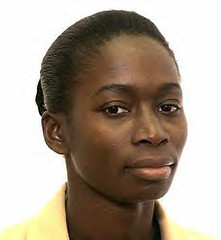
Nyamko Ana Sabuni Selected as Minister in Sweden For the Liberal Party
Originally uploaded by panafnewswire.
10.25.2006
Nyamko Ana Sabuni, a naturalised Swede of DR Congo origin has been appointed the Swedish Integration and Sexual Equality Minister, the Congolese news agency, ACP, reports.
A member of the Swedish Liberal Party, Sabuni will seat on the new 21-member cabinet of Prime Minister Fredrik Reinfeldt, as the first person of African descent to be appointed into the Swedish government.
Born in the Congo on March 3 1969, Sabuni emigrated to Sweden at the age of 12 and became a member of the Riskdag (Parliament) in 2002.
In 2004, she became a member of her party's Steering Committee.
The new minister reportedly went into active politics following the killing in Klippan of Gérard Gbeyo - a Swedish African - by a racist bigot.
Sabuni has distinguished herself as a minority rights activist fighting the cause of Africans in Sweden, and against female genital mutilation.
Political analyst say her first challenge will be steering national integration in an environment facing growing xenophobia, not only in Sweden but across Europe, with right-wing parties making significant inroads into national politics.
Another woman of Congolese origin, Mrs Gisèle Mandaila is Secretary of State for Humanitarian Affairs in Belgium, a former colonial power in the Congo.
Tuesday, Oct 24, 2006
Ethiopia's famed Lucy fossils to go on display abroad for first time
ADDIS ABABA, Ethiopia (AP) - One of the world's most famous fossils, the 3.2 million-year-old Lucy skeleton unearthed in Ethiopia in 1974, will go on display abroad for the first time in the United States, officials said Tuesday.
Even the Ethiopian public has only seen Lucy twice. The Lucy exhibition at the Ethiopian Natural History Museum in the capital, Addis Ababa, is a replica while the real remains are usually locked in a vault. A team from the Museum of Natural Science in Houston, Texas, spent four years negotiating the U.S. tour, which will start in Houston next September.
"Ethiopia's rich cultural heritage, and the vibrant country that it is today, is one of the best kept secrets in the world," said Joel Bartsch, director of the Houston museum.
The six-year tour will also go to Washington, New York, Denver and Chicago. Officials said six other U.S. cities may be on the tour. But they would not release the names, saying all the details had not yet been ironed out.
Travelling with Lucy will be 190 other fossils, artifacts and relics.
Security will be extremely tight amid concerns of possible theft or damage. Officials refused to say how much they had insured Lucy for or how much the Ethiopian government was being paid. Tourism and Culture Minister Muhammed Dirir did say money from the deal will go toward upgrading and building new museums in Ethiopia, one of the world's poorest countries.
Lucy, her name taken from a Beatles song that played in an archaeological camp the night of her discovery, is the partial skeleton of what was once a one-metre-tall adult of an ape-man species.
The fossilized remains were discovered in the remote, desert-like Afar region in northeastern Ethiopia by U.S. paleontologists Donald Johanson and Tom Gray.
The creature was a member of Australopithecus afarensis, which lived in Africa between about four million and three million years ago, and is the earliest known hominid.
Most scientists believe afarensis stood upright and walked on two feet, but they argue about whether it had ape-like agility in trees. The loss of that ability would suggest crossing a threshold toward a more human existence.
Debate still rages over how close an ancestor to man Lucy would be, as many experts suspect she was anatomically far closer to apes than humans.
No comments:
Post a Comment